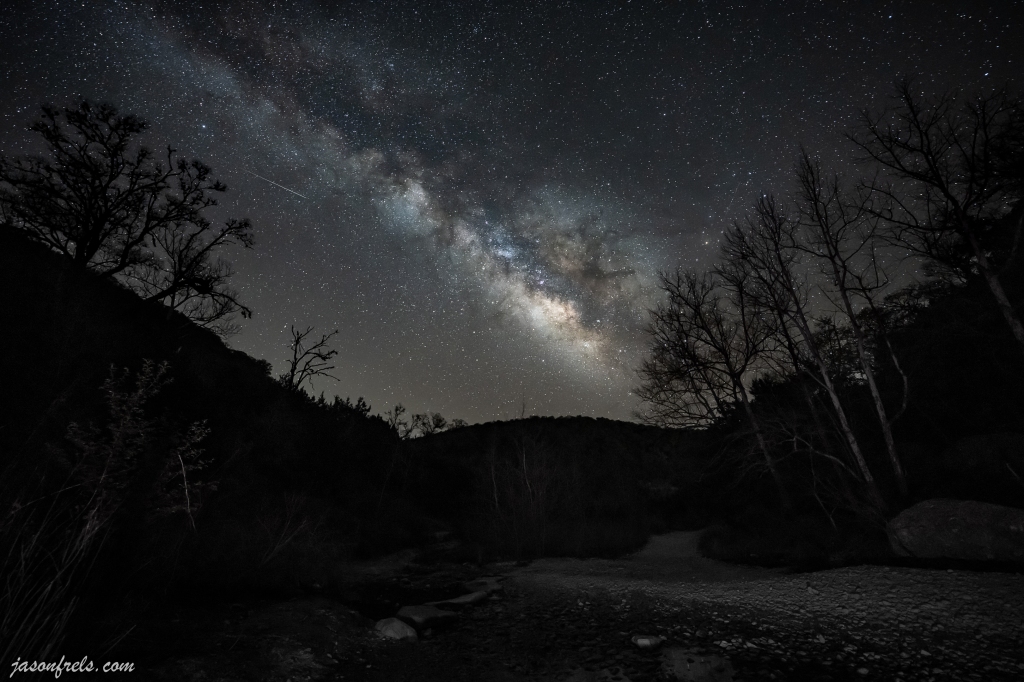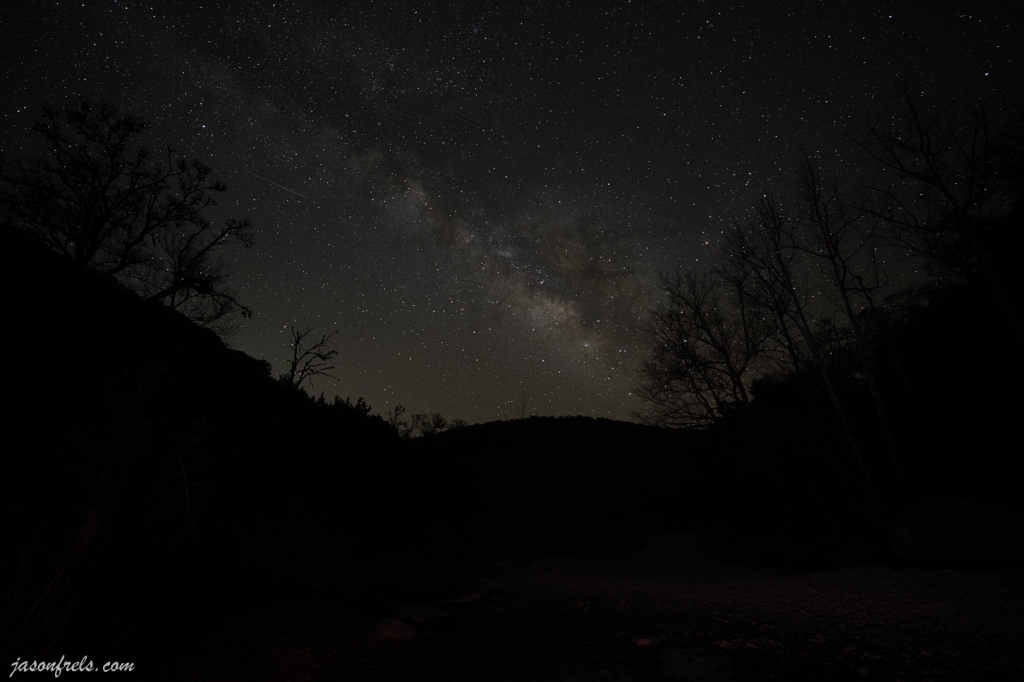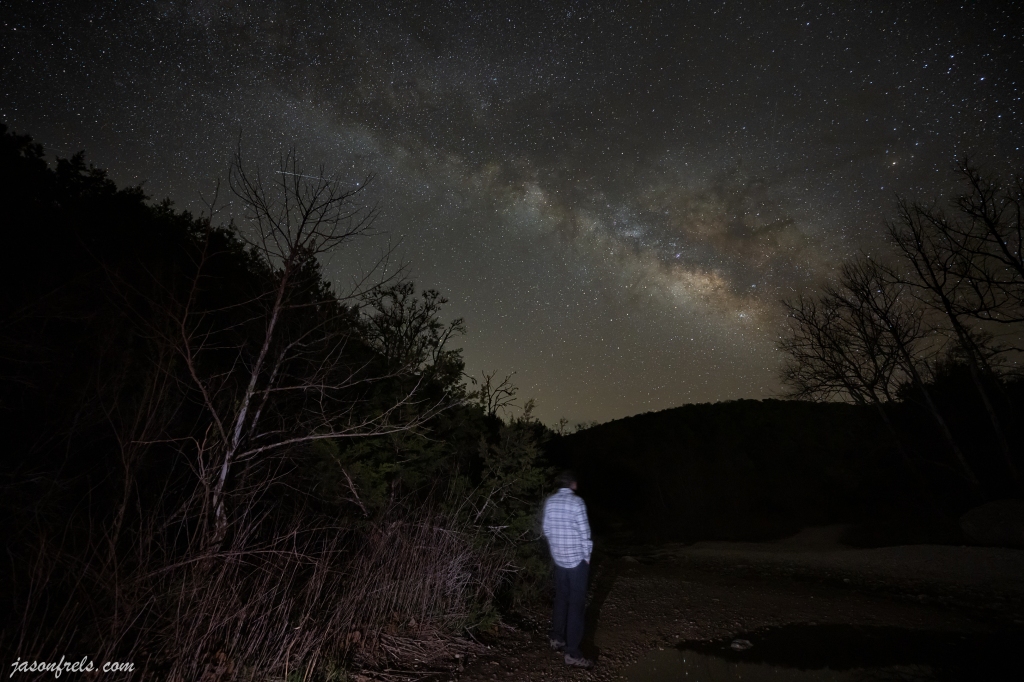If you want to see the core of the Milky Way, you have to view it at the right time of year. As the Earth orbits the sun, the galactic core rises and sets at different times throughout the year. In the Northern Hemisphere this means that in the dead of winter the galactic core rises and sets between morning twilight and evening twilight and is not visible because it is up during the day. But in spring, the core begins rising just before predawn twilight and you will have a chance to view it on a clear and moonless night. As spring turns into summer, the core rises progressively earlier until you have most of the night to view it. And by the end of November it is setting early in the evening and becomes invisible again. Your available time for viewing is also affected by the shorter nights in summer and lengthening nights as autumn progresses.
You also need a place with very little light pollution and a moonless night sky. Lost Maples State Natural Area in Texas has very dark skies on a moonless night as it doesn’t suffer from a lot of light pollution from nearby cities. This makes it a very good place to view the night sky. But its remoteness also makes it a long drive to get to.

Midday Saturday, it was a clear day and I got the sudden urge to shoot the night sky. I checked the moonset time and found that it would set at about 9:30PM, which is perfect as it is difficult to see the Milky Way with the bright moon in the sky. I checked when the galactic core would be visible and found that it would rise a few hours before astronomical twilight begins in the morning, which is acceptable to me. I then began checking a couple of State Parks that had reasonably dark skies to see if they had any available camping. Colorado Bend State Park was full, as it usually is on the weekends. But Lost Maples had some available drive-up camp sites so I reserved one and developed a quick plan.
I spent a little time looking at a satellite map and found an area that would be an easy hike in the predawn darkness. I quickly packed my car and hit the road. When I got there I would have at least 3 hours of daylight to scout my location, do a little hiking, and set up my tent.
My planned location to scout was just up the Maple Trail and less than half a mile from the trailhead parking lot. The trail runs along a creek bed with good visibility to the south, which is where the galactic core is generally seen. There was an open grassy area that offered a good view of the sky, but I ended up settling on some larger boulders along the creek bed. I selected a rough compositional idea and used the PhotoPills app AR to determine where the galactic core would be the following morning at around 5:30AM. Astronomical twilight begins at 5:58AM, so I should have at least an hour to get some photos if I get down there by 5:00AM.

So with that all planned out, I finished my hiking and got my camp set up for the evening. I left the outer cover off the top of my tent so I could look up through the netting and see the stars. It is always amazing when I see the night sky from a place like this as I live in the city and kind of get used to only seeing the few brightest stars against the light pollution. It really defies literal explanation or even photography and you have to see it for yourself.
I was awake by 4:30AM and I could already see the Milky Way from the door of my tent. I headed for the trailhead and got to my location with plenty of time to take in the stars. There was the galactic core right where it was supposed to be.

You can see just how dark it was by looking at the landscape in the photo. It is almost completely black except for the boulder which I shined a little light on so it would show up in the photo. There were a few clouds on the horizon when I got there, but they were nice enough to blow away quickly.
I had wanted some sort of landscape foreground for my night sky photos this time and I thought that boulder and stream bed would be nice, but I found that it didn’t work as well as I thought it would with the rest of the canyon being so dark. So, I moved more toward the center of the path and tried some other angles. Using my head lamp filtered by my shirt I composed a view looking across the creek and back down the trail toward the Milky Way. I think that worked better.

In post-processing I brushed a mask over the Milky Way and increased the contrast and exposure and then applied some dehaze and/or clarity to exaggerate it a bit. I also brought up the landscape so you could see the trail and reduced saturation. With that, working on the trees, and other adjustments, I probably have an hour and half of time in processing that image. I hope you don’t think I overdid it. If you would like to see the RAW image before I applied any edits to it, I have posted it below.

Another thing that you might notice is that it is difficult to take a night sky photo without a satellite streak, especially close to sunset or sunrise when the satellites are catching sun. So, just about every one of my photos has a streak or two. Thanks Starlink. I guess I can come back in a couple of months and do all this at 1:00AM and try avoid this if I want to.
And lastly here is a selfie. I am a bit blurry as it is a 20 second exposure and I didn’t remain perfectly still standing on the muddy rocks. My headlamp was wrapped in a shirt on the ground next to the tripod. I was attempting to be gazing ponderously at the heavens.

The sky in these photographs is processed to bring out detail. To my eyes, it is fainter and paler and I don’t discern the color that the camera does. But I also didn’t give my eyes enough time to adjust to the dark as I kept checking the camera screen. To get the best view, you would suppress the urge to constantly check your phone and let your eyes adjust to the dark conditions for at least 15 minutes. When I have sat and let my eyes adjust, I find that I can see a lot more of the detail as seen in the photos.
It is sad that we live without the full beauty of the night sky in our lives in these days of electric lights. A century or so ago, when it was still expensive to have light at night, this is what you saw when you looked up at night sky. I blame the electrical engineers. Thanks for reading.

Very impressive shots. An hour-and-a-half of processing time is a lot of time for just one photo. Looks great, though. I like that trick of shining a light on the rock to get some foreground image.
LikeLiked by 1 person
People use different colored lights to light different things. Maybe I need to up my lighting game a bit.
LikeLiked by 1 person
Sure, but you might have to get a bigger backpack.
LikeLiked by 1 person
With the camera, two lenses, and a tripod it is already big and heavy enough for me. My only other option is losing some weight.
LikeLiked by 1 person
You can try tying helium balloons to it.
LikeLiked by 2 people
Why didn’t I think of that. Not to inflate your ego, but you come up with lofty ideas sometimes.
LikeLiked by 2 people
I’m glad I could lift your spirits.
LikeLiked by 1 person
Don’t worry I will try to deflate his inflated ego.
LikeLiked by 1 person
I thought you were kind.
LikeLiked by 1 person
Oooh….😶🤚!
LikeLiked by 1 person
That’s five head smacks today by my count. You should sleep well tonight.
LikeLike
How “thoughtful” of you to point that out! Someone went above their quota today, won’t happen tomorrow!
LikeLiked by 1 person
Yes, take care of yourself
LikeLike
LOL! Thanks, as I shake my head. Ironically enough I bought a new pillow and will be sleeping on it tonight. Its extra fluffy. 😊
LikeLiked by 1 person
That will help you dream up what happens to Nicole. And thanks for posting my picture by the way.
LikeLiked by 1 person
That would be a good thing, for I only have a vague idea right now of what may happen.
You are very welcome. You just don’t know when you may see a photo of yours. 😉
Thanks for letting me use them. Always nice to have somewhere else besides Pinterest for photos that inspire.
LikeLike
The one that I spent all the time on got added to Explore on Flickr this morning, which means it is put in their main feed to be viewed by thousands of people. So that is nice.
LikeLiked by 2 people
That’s great. So you’re famous now. I guess all that hard work paid off.
LikeLiked by 2 people
Yes, I am payed in Faves on Flickr. I try to calculate the dollars to Faves ratio, but I get a divide-by-zero error.
LikeLiked by 2 people
Since I don’t use Flickr, I haven’t a flicker of an idea what you’re talking about. But dividing by zero doesn’t sound very profitable.
LikeLiked by 1 person
It is equivalent to likes on WordPress in that you are paid in adulation by your fans. I estimate that the conversion rate for this adulation currency is $0.00000000 per unit of adulation. So, if you could get everyone on earth to like a post, it would be worth approximately $0 (before subtracting the cost of creating the content). But, think about how this scales with volume!
LikeLiked by 1 person
I’d want a few more zeroes tacked to the end of that, before I’d be willing to consider it.
LikeLiked by 1 person
That is the great think about zeros on the right side of the decimal point; you can have as many as you want!
LikeLiked by 2 people
Wow, you’re starting to talk me into it. You could probably get a job selling land for a land developer.
LikeLiked by 2 people
As long as my commission is not in adulation.
LikeLiked by 2 people
Then I promise I won’t give you the clap.
LikeLiked by 1 person
Well, that cheers me up.
LikeLiked by 2 people
He prefers gold stars 🌟 🌟🌟🌟🌟
LikeLiked by 1 person
I don’t blame him.
LikeLiked by 1 person
Oh stop. You’re embarrassing me.
LikeLiked by 2 people
😳 Flushed cheeks? Good! I think you are due your turn. 🙂
LikeLiked by 1 person
Flushed Cheeks? I believe I have that brand toilet.
LikeLiked by 1 person
😶🤚! You just had to make me break my record of a no “head smack” day, didn’t you. 😛
LikeLiked by 1 person
I try to encourage you to break records.
LikeLiked by 1 person
Oooh the “helpful” part of you coming out again, isn’t it.
LikeLiked by 1 person
You say that like it’s a bad thing.
LikeLike
Hmmm….”No comment!” doolally!
LikeLiked by 1 person
Did you see the Texas “love birds” on Bing? 🙂
LikeLike
Now dividing something by 0 is math that even I can do. 🙂
Congrats about the photo!
LikeLiked by 1 person
Dividing by zero is math that nobody can do. It is a calculus problem that approaches infinity.
LikeLiked by 1 person
So I guess that I can do the impossible! 😉
And don’t bring calculus into my simple math problem.
LikeLike
Ask your calculator what 5/0 is.
LikeLiked by 1 person
If I did that, the answer may make me …”smack my head”…I i have done well at avoiding that so far today. 🙂
LikeLiked by 1 person
Being a morning person pays off! Love the photos. In your selfie you are pondering what your wish should be and what star to wish on, right? We truly do have an amazing sky!
LikeLiked by 1 person
Hmmm….. what do I wish for? I’d have to give it some thought.
Maybe wish I could eat and drink anything I want without gaining weight or suffering health problems.
LikeLike
I like that wish, sounds good to me! Now go back out there to make your wish. 🙂
LikeLiked by 1 person
Don’t they have stars in Pennsylvania?
LikeLiked by 1 person
Yes, all I have to do is go out my back door, you are the one who lives in the city. I can make my wish any night. Well as long as its not cloudy. And the neighbors lights don’t get in the way.
LikeLiked by 1 person
Do those wishes work out for you or does that cow hanging around out back intercept them?
LikeLiked by 1 person
So thats why my wishes aren’t coming true! Its all Betsy’s fault! 😶🤚!
LikeLiked by 1 person
[…] Anyway, I hiked and camped and got up and shot the stars early in the morning. You can read about that here. […]
LikeLike
Nice work Jason. This is something I have been intending to try for a while as I recently moved to the west of Scotland where there isn’t a lot of light pollution. I have been watching a few videos on the Photopills app. How easy did you find it to get to grips with the App?
LikeLiked by 1 person
The app is mostly intuitive, some of the indicator lines are a little cryptic so you have to dig in. But for planning the Milky Way shots, it has been very accurate.
LikeLiked by 1 person
Thank you, I will give it a shot
LikeLike
There is also a website called darksitefinder that I use. It has been very helpful
LikeLiked by 1 person
Thanks, I will check it out
LikeLike
It seems to be much more add-ridden than it used to be
LikeLiked by 1 person